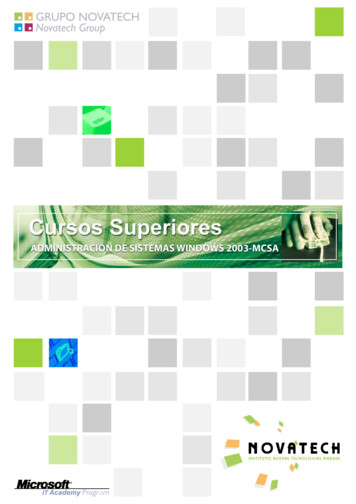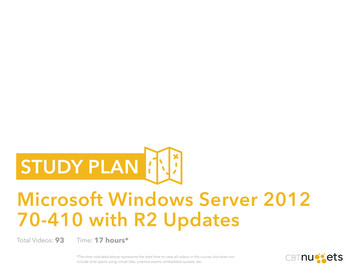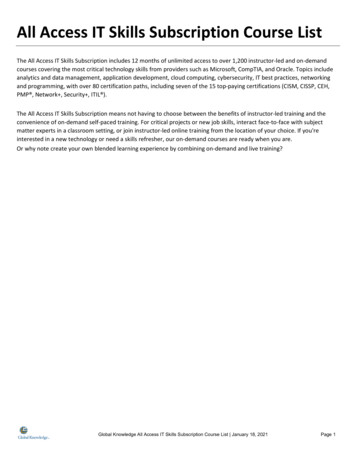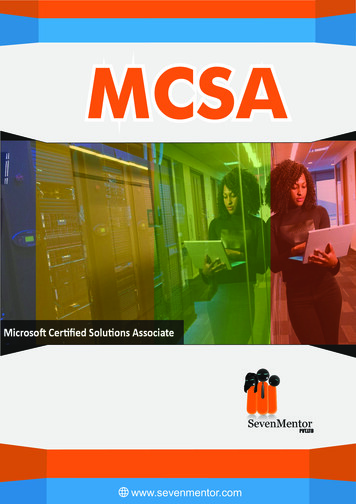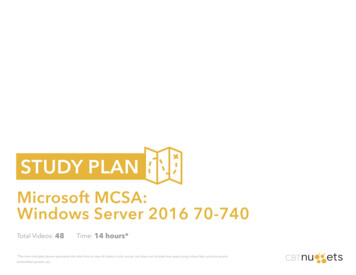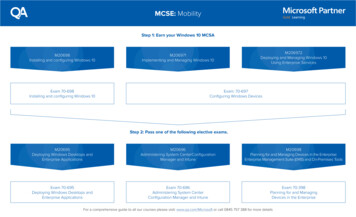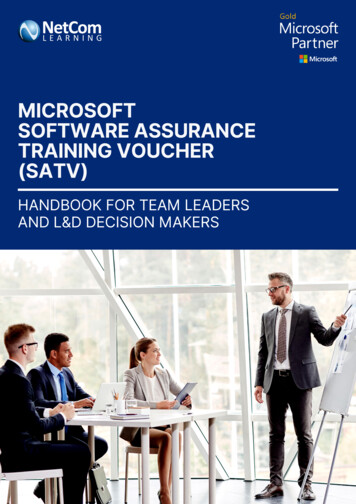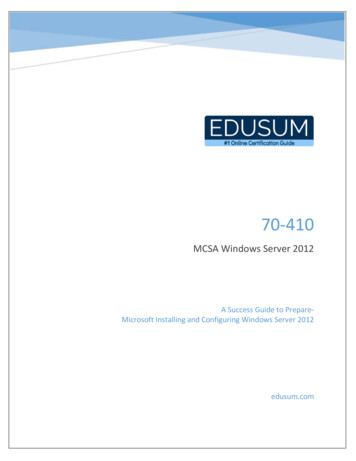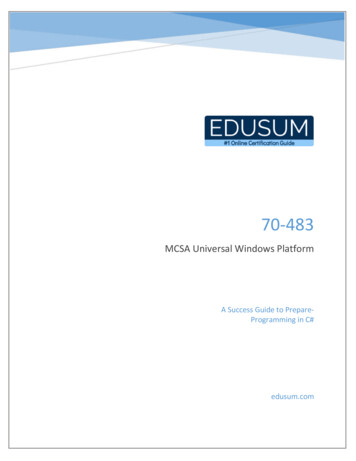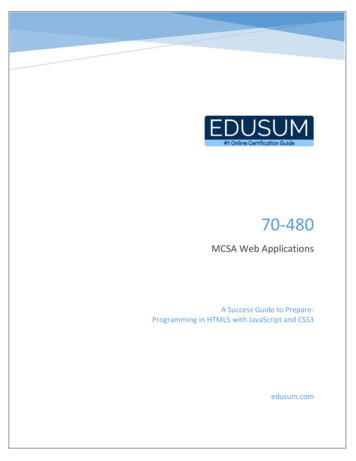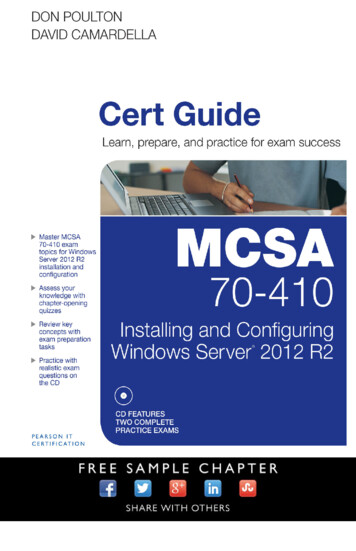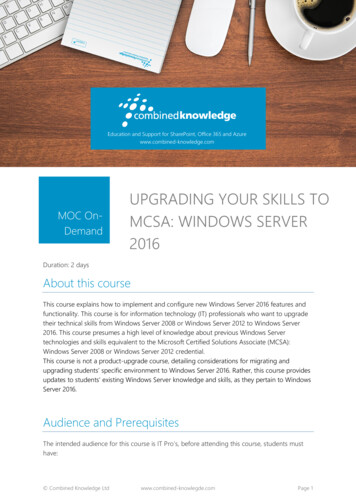
Transcription
Education and Support for SharePoint, Office 365 and Azurewww.combined-knowledge.comMOC OnDemandUPGRADING YOUR SKILLS TOMCSA: WINDOWS SERVER2016Duration: 2 daysAbout this courseThis course explains how to implement and configure new Windows Server 2016 features andfunctionality. This course is for information technology (IT) professionals who want to upgradetheir technical skills from Windows Server 2008 or Windows Server 2012 to Windows Server2016. This course presumes a high level of knowledge about previous Windows Servertechnologies and skills equivalent to the Microsoft Certified Solutions Associate (MCSA):Windows Server 2008 or Windows Server 2012 credential.This course is not a product-upgrade course, detailing considerations for migrating andupgrading students’ specific environment to Windows Server 2016. Rather, this course providesupdates to students' existing Windows Server knowledge and skills, as they pertain to WindowsServer 2016.Audience and PrerequisitesThe intended audience for this course is IT Pro’s, before attending this course, students musthave: Combined Knowledge Ltdwww.combined-knowlegde.comPage 1
Two or more years of experience with deploying and managing Windows Server 2012or Windows Server 2008 environments; NS experience with day-to-day WindowsServer 2012 or Windows Server 2008 system-administration management andmaintenance tasks. Experience with Windows networking technologies and implementation. Experience with Active Directory technologies and implementation. Experience with Windows Server virtualization technologies and implementation. Knowledge equivalent to the MCSA credentials of Windows Server 2008 or WindowsServer 2012.Audience ProfileThis course is for IT professionals who are experienced Windows Server 2012 or WindowsServer 2008 system administrators, with real-world experience working in a Windows Server2008 R2 or Windows Server 2008 enterprise environment. Additionally, students should haveobtained the MCSA credential for Windows Server 2008 or Windows Server 2012, or theyshould have equivalent knowledge.Additionally, IT professionals who plan to take the Microsoft Certified Solutions Expert (MCSE)exams might be interested in this course, as preparation for the MCSA exams, which are aprerequisite for the MCSE specialties.At Course CompletionAfter completing this course, students will be able to: Install and configure Windows Server 2016. Describe storage in Windows Server 2016. Implement directory services. Implement Active Directory Federation Services (AD FS). Describe networking. Implement Hyper-V. Configure advanced networking features. Implement software-defined networking. Implement remote access. Deploy and manage Windows and Hyper-V containers. Implement failover clustering. Implement failover clustering by using virtual machines. Combined Knowledge Ltdwww.combined-knowlegde.comPage 2
Course OverviewModule 1- Installing and Configuring Windows Server2016This module explains how to install and perform post-installation configuration of WindowsServer 2016 servers.Lessons Introducing Windows Server 2016 Installing Windows Server 2016 Configuring Windows Server 2016 Preparing for upgrades and migrations Migrating server roles and workloads Windows Server activation modelsLab : Installing and configuring Nano Server Installing Nano Server Completing post-installation tasks on Nano ServerAfter completing this course, students will be able to: Explain Windows Server 2016. Install Windows Server 2016. Configure Windows Server 2016. Prepare for upgrades and migrations. Migrate server roles and workloads. Describe the Windows Server activation models.Module 2- Overview of Storage in Windows Server2016This module explains how to configure storage in Windows Server 2016.Lessons Overview of storage in Windows Server 2016 Configuring Internet SCSI (iSCSI) storage Configuring the Storage Spaces feature in Windows Server 2016 Implementing the Data Deduplication featureLab : Implementing and managing storage Implementing File Server Resource Manager (FSRM) Configuring iSCSI storageLab : Configuring storage spaces Configuring redundant storage spaces Combined Knowledge Ltdwww.combined-knowlegde.comPage 3
Implementing the Storage Spaces Direct featureAfter completing this module, students will be able to: Explain storage in Windows Server 2016. Configure iSCSI storage. Configure the Storage Spaces feature in Windows Server 2016. Implement Data Deduplication.Module 3- Implementing the Directory ServicesFeatureThis module explains how to implement the Directory Services feature.Lessons Deploying AD DS domain controllers Implementing service accounts What is Azure AD?Lab : Implementing and Managing AD DS Cloning an AD DS domain controller Implementing service accountsAfter completing this module, students will be able to: Deploy AD DS domain controllers. Implement service accounts. Explain Azure AD.Module 4- Implementing AD FSThis module explains how to implement an AD FS deployment.Lessons Overview of AD FS Deploying AD FS Implementing AD FS for a single organization Implementing Web Application Proxy Implementing Azure AD FS SSO with Microsoft Online ServicesLab : Implementing AD FS Installing and configuring AD FS Configuring an internal application for AD FSLab : Implementing Web Application Proxy Implementing Web Application ProxyAfter completing this module, students will be able to: Describe of AD FS. Deploy AD FS. Implement AD FS for a single organization. Combined Knowledge Ltdwww.combined-knowlegde.comPage 4
Implement Web Application Proxy. Implement Azure AD FS SSO with Microsoft Online Services.Module 5- Implementing Network ServicesThis module explains how to configure advanced features for Dynamic Host ConfigurationProtocol (DHCP) and configure IP Address Management (IPAM).Lessons Overview of networking enhancements Implementing the IP address management Managing IP address spaces with IPAMLab : Implementing network services Configuring DNS policies Configuring DHCP failover Configuring IPAMAfter completing this module, students will be able to: Describe networking enhancements. Implement IP address management. Manage IP address spaces with IPAM.Module 6- Implementing Hyper-VThis module explains how to install and configure Hyper-V virtual machines.Lessons Configuring the Hyper-V role in Windows Server 2016 Configuring Hyper-V storage Configuring Hyper-V networking Configuring Hyper-V virtual machinesLab : Implementing server virtualization with Hyper-V Installing the Hyper-V server role Configuring virtual networking Creating and configuring a VMAfter completing this module, students will be able to: Configure the Hyper-V role in Windows Server 2016. Configure Hyper-V storage. Configure Hyper-V networking. Configure Hyper-V virtual machines. Combined Knowledge Ltdwww.combined-knowlegde.comPage 5
Module 7- Configuring Advanced NetworkingFeaturesThis module explains how to implement an advanced networking infrastructure.Lessons Overview of high-performance networking features Configuring advanced Hyper-V networking featuresLab : Configuring advanced Hyper-V networking features Creating and using Microsoft Hyper-V virtual switches Configuring and using the advanced features of a virtual switchAfter completing this module, students will be able to: Describe high-performance networking features. Configure advanced Hyper-V networking features.Module 8 – Implementing Software DefinedNetworkingThis module explains how to implement software-defined networking.Lessons Overview of software-defined networking Implementing network virtualization Implementing the Network Controller featureLab : Implementing Network Controller Deploying Network Controller Configuring network services with Network Controller Managing and monitoring with Network ControllerAfter completing this module, students will be able to: Describe software defined networking. Implement network virtualization. Implement Network Controller.Module 9 – Implementing Remote AccessThis module explains how to configure connectivity for remote users by using the DirectAccessfeature.Lessons Remote access overview Implementing DirectAccess Implementing a virtual private network (VPN) Combined Knowledge Ltdwww.combined-knowlegde.comPage 6
Lab : Implementing DirectAccess Configuring DirectAccess by using the Getting Started Wizard Testing DirectAccessAfter completing this module, students will be able to: Describe common remote-access solutions and technologies. Implement DirectAccess. Implement VPNs.Module 10- Deploying and Managing WindowsServer and Hyper-V ContainersThis module provides an overview of Windows Server 2016 containers. Additionally, it explainshow to deploy, install, configure, and manage containers in Windows Server 2016.Lessons Overview of Windows Server 2016 containers Deploying Windows Server and Hyper-V containers Installing, configuring, and managing containersLab : Installing and configuring containers Installing and configuring Windows Server containers by using Windows PowerShell Installing and configuring Windows Server containers by using the Docker engineAfter completing this module, students will be able to: Explain the purpose of Windows Server and Hyper-V containers. Deploy and manage Windows Server and Hyper-V containers. Install, configure, and manage containers.Module 11– Implementing Failover ClusteringThis module explains how to implement failover clustering to provide high availability fornetwork services and applications.Lessons Overview of failover clustering Implementing a failover cluster Configuring highly-available applications and services on a failover cluster Maintaining a failover cluster Implementing a stretch clusterLab : Implementing failover clustering Configuring iSCSI storage Configuring a failover cluster Deploying and configuring a highly-available file server Validating the deployment of a highly-available file server Combined Knowledge Ltdwww.combined-knowlegde.comPage 7
Configuring the Cluster-Aware Updating feature on the failover clusterAfter completing this module, students will be able to: Describe the concept of failover clustering. Implement a failover cluster. Configure highly-available applications and services on a failover cluster. Maintain a failover cluster. Implement a stretch-failover cluster.Module 12- Implementing Failover Clustering withWindows Server 2016 Hyper-VThis module explains how to deploy and manage Hyper-V virtual machines in a failover cluster.Lessons Overview of the integration of Hyper-V Server 2016 with failover clustering Implementing Hyper-V virtual machines on failover clusters Implementing Windows Server 2016 Hyper-V virtual machine migration Implementing the Hyper-V Replica featureLab : Implementing failover clustering with Windows Server 2016 Hyper-V Configuring Hyper-V Replica Configuring a failover cluster for Hyper-V Configuring a highly available virtual machineAfter completing this module, students will be able to: Describe how Windows Server 2016 Hyper-V integrates with failover clustering. Implement Hyper-V virtual machines on failover clusters. Implement Hyper-V virtual machine migration. Implement Hyper-V Replica. Combined Knowledge Ltdwww.combined-knowlegde.comPage 8
technologies and skills equivalent to the Microsoft Certified Solutions Associate (MCSA): Windows Server 2008 or Windows Server 2012 credential. This course is not a product-upgrade course, detailing considerations for migrating and upgrading students' specific environment to Windows Server 2016. Rather, this course provides
